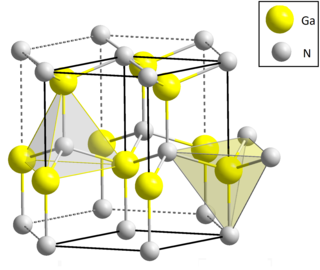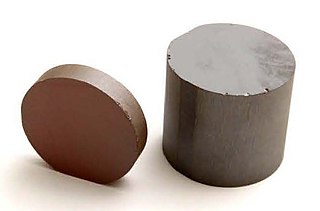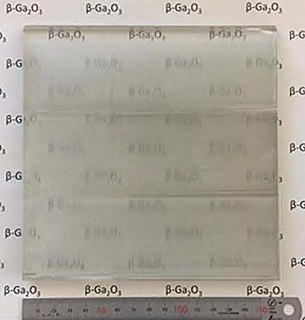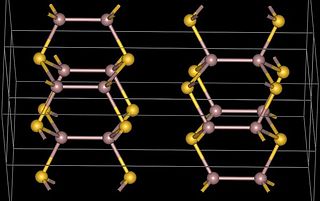
Gallium arsenide (GaAs) is a compound of the elements gallium and arsenic. It is a III-V direct bandgap semiconductor with a zinc blende crystal structure.

Sphalerite ( S) is a mineral that is the chief ore of zinc. It consists largely of zinc sulfide in crystalline form but almost always contains variable iron. When iron content is high it is an opaque black variety, marmatite. It is usually found in association with galena, pyrite, and other sulfides along with calcite, dolomite, and fluorite. Miners have also been known to refer to sphalerite as zinc blende, black-jack and ruby jack.
Briartite is an opaque iron-grey metallic sulfide mineral, Cu2(Zn,Fe)GeS4 with traces of Ga and Sn, found as inclusions in other germanium-gallium-bearing sulfides.

Gallium nitride (GaN) is a binary III/V direct bandgap semiconductor commonly used in light-emitting diodes since the 1990s. The compound is a very hard material that has a Wurtzite crystal structure. Its wide band gap of 3.4 eV affords it special properties for applications in optoelectronic, high-power and high-frequency devices. For example, GaN is the substrate which makes violet (405 nm) laser diodes possible, without use of nonlinear optical frequency-doubling.
Gallium hydroxide, Ga(OH)3 is formed as a gel following the addition of ammonia to Ga3+ salts. It is also found in nature as the rare mineral söhngeite which is reported to contain octahedrally coordinated gallium atoms
Gallium hydroxide is amphoteric. In strongly acidic conditions, the gallium ion, Ga3+ is formed. In strongly basic conditions, Ga(OH)4− is formed. Salts of Ga(OH)4− are sometimes called gallates.

Gallium phosphide (GaP), a phosphide of gallium, is a compound semiconductor material with an indirect band gap of 2.24 eV at room temperature. The polycrystalline material has the appearance of pale orange or grayish pieces. Undoped single crystals are orange, but strongly doped wafers appear darker due to free-carrier absorption. It is odorless and insoluble in water.
A gallium scan is a type of nuclear medicine test that uses either a gallium-67 (67Ga) or gallium-68 (68Ga) radiopharmaceutical to obtain images of a specific type of tissue, or disease state of tissue. Gallium salts like gallium citrate and gallium nitrate may be used. The form of salt is not important, since it is the freely dissolved gallium ion Ga3+ which is active. Both 67Ga and 68Ga salts have similar uptake mechanisms. Gallium can also be used in other forms, for example 68Ga-PSMA is used for cancer imaging. The gamma emission of gallium 67 is imaged by a gamma camera, while the positron emission of gallium 68 is imaged by positron emission tomography (PET).

Gallium(III) bromide (GaBr3) is a chemical compound, and one of four Gallium trihalides.

Gallium(III) fluoride (GaF3) is a chemical compound. It is a white solid that melts under pressure above 1000 °C but sublimes around 950 °C. It has the FeF3 structure where the gallium atoms are 6-coordinate. GaF3 can be prepared by reacting F2 or HF with Ga2O3 or by thermal decomposition of (NH4)3GaF6. GaF3 is virtually insoluble in water. Solutions of GaF3 in HF can be evaporated to form the trihydrate, GaF3·3H2O, which on heating gives a hydrated form of GaF2(OH). Gallium(III) fluoride reacts with mineral acids to form hydrofluoric acid.

Gallium(III) iodide is the chemical compound with the formula GaI3. It is the most common iodide of gallium. In the chemical vapor transport method of growing crystals of gallium arsenide uses iodine as the transport agent. It also exists as a dimer, Ga2I6.

Gallium(III) trioxide is an inorganic compound with the formula Ga2O3. It exists as several polymorphs, all of which are white, water-insoluble solids. Although no commercial applications exist, Ga2O3 is an intermediate in the purification of gallium, which is consumed almost exclusively as gallium arsenide.

Gallium(II) telluride, GaTe, is a chemical compound of gallium and tellurium.
There is research interest in the structure and electronic properties of GaTe because of the possibility that it, or related compounds, may have applications in the electronics industry. Gallium telluride can be made by reacting the elements or by metal organic vapour deposition (MOCVD).
.
GaTe produced from the elements has a monoclinic crystal structure. Each gallium atom is tetrahedrally coordinated by 3 tellurium and one gallium atom. The gallium-gallium bond length in the Ga2 unit is 2.43 Angstrom. The structure consists of layers and can be formulated as Ga24+ 2Te2−. The bonding within the layers is ionic-covalent and between the layers is predominantly van der Waals. GaTe is classified as a layered semiconductor (like GaSe and InSe which have similar structures). It is a direct band gap semiconductor with an energy of 1.65eV at room temperature.
A hexagonal form can be produced by low pressure metal organic vapour deposition (MOCVD) from alkyl gallium telluride cubane-type clusters e.g. from (t-butylGa( μ3-Te))4. The core consists of a cube of eight atoms, four gallium, and four tellurium atoms. Each gallium has an attached t-butyl group and three adjacent tellurium atoms and each tellurium has three adjacent gallium atoms. The hexagonal form, which is closely related to the monoclinic form, containing Ga24+ units, converts to the monoclinic form when annealed at 500 °C.

Gallium trichloride is the chemical compound with the formula GaCl3. Solid gallium trichloride exists as a dimer with the formula Ga2Cl6. It is colourless and soluble in virtually all solvents, even alkanes, which is truly unusual for a metal halide. It is the main precursor to most derivatives of gallium and a reagent in organic synthesis.

Organogallium chemistry is the chemistry of organometallic compounds containing a carbon to gallium (Ga) chemical bond. Despite their high toxicity, organogallium compounds have some use in organic synthesis. The compound trimethylgallium is of some relevance to MOCVD as a precursor to gallium arsenide via its reaction with arsine at 700 °C:
Gallane, also systematically named trihydridogallium, is an inorganic compound of gallium with the chemical formula GaH
3. It is a photosensitive, colourless gas that cannot be concentrated in pure form. Gallane is both the simplest member of the gallanes, and the prototype of the monogallanes. It has no economic uses, and is only intentionally produced for academic reasons.
The glass forming ability of gallium(III) sulfide and lanthanum sulfide was discovered in 1976 by Loireau-Lozac’h, Guittard, and Flahut. This family of chalcogenide glasses, referred to as gallium lanthanum sulfide (Ga-La-S) glasses, have a wide region of glass formation centred about the 70Ga2S3:30La2S3 composition and can readily accept other modifiers into their structure. This means that Ga-La-S can be compositionally adjusted to give a wide variety of optical and physical properties. Optically, Ga-La-S has a high refractive index, a transmission window covering most of the visible wavelengths and extending to about 10 µm and a low maximum phonon energy, approx. 450 cm−1. Thermally, the refractive index of Ga-La-S glasses has a strong temperature dependence and low thermal conductivity, which results in strong thermal lensing. However, the high glass transition temperature of Ga-La-S makes it resistant to thermal damage, it has good chemical durability and unlike many chalcogenides which are based on arsenic, its glass components are non-toxic. A clear advantage over other chalcogenides is its high lanthanum content which allows excellent rare-earth solubility and dispersion of the ions in the glass matrix for active devices. Ga-La-S can exist in both glassy and crystalline phases, in a glassy phase, it is a semiconductor with a bandgap of 2.6 eV corresponding to a wavelength of 475 nm; consequently Ga-La-S glass takes a deep orange colour. As with all chalcogenides the phase of the bulk is determined by two key factors; the material composition and the rate at which the molten material is cooled. These variables can be controlled to manipulate the final phase of the material.
Gallium(I) oxide, digallium monoxide or gallium suboxide is an inorganic compound with the formula Ga2O.










